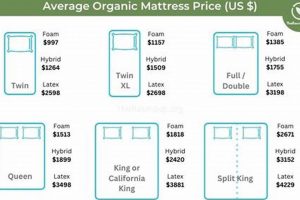The dimensions of a standard double bed, frequently sought after for single sleepers desiring extra space or couples with compact living environments, typically encompass a width of approximately 54 inches and a length of 75 inches. These figures serve as critical benchmarks for manufacturers, retailers, and consumers alike, ensuring compatibility with bed frames, bedding, and room layouts. Accurate knowledge of these dimensions allows for informed purchasing decisions and optimized space utilization.
Understanding the size parameters of this common bedding choice offers several advantages. It simplifies the process of selecting appropriate sheets, comforters, and mattress protectors. Furthermore, it aids in effectively planning bedroom arrangements, ensuring that the chosen bed will fit comfortably within the available area while allowing for adequate walking space and furniture placement. Historically, this particular size has provided a balance between economy and comfort, representing a practical solution for diverse sleeping needs.
The subsequent sections will delve into a detailed examination of factors influencing dimensional variations, a comparison with alternative mattress sizes, and practical guidance for utilizing size data during the purchasing and setup stages. This will include examining how manufacturing tolerances and material composition can impact the overall dimensions, as well as offering advice on how to accurately measure the available space in a bedroom.
Essential Considerations for Full Mattress Dimensions
The following recommendations provide pertinent guidance regarding the spatial attributes of a full-size mattress, intended to facilitate informed decisions during purchase, setup, and accessory selection.
Tip 1: Prior to purchase, meticulously measure the intended bedroom space. Accurately assess the available area to guarantee the mattress fits comfortably, allowing for movement and the placement of additional furniture.
Tip 2: When acquiring bedding accessories, such as sheets and comforters, ensure compatibility with the established mattress size. Deviation from standard dimensions may result in ill-fitting linens and compromised comfort.
Tip 3: Account for potential variations in manufacturing tolerances. Slight dimensional discrepancies may exist between different brands or models; therefore, confirm exact measurements when feasible.
Tip 4: Consider the impact of mattress height on overall bed dimensions. A thicker mattress may necessitate adjustments in bed frame selection or require deeper pocket sheets.
Tip 5: When replacing an existing mattress, verify the dimensions of the current bed frame. The frame should adequately support the new mattress without causing overhang or instability.
Tip 6: If sharing the mattress, evaluate whether the width provides sufficient personal space for comfortable sleep. Inadequate space can disrupt sleep quality.
Tip 7: Be mindful of doorway and stairwell clearances during delivery. Large mattresses may present logistical challenges when maneuvering them into the bedroom.
Adherence to these guidelines fosters a more streamlined and satisfactory experience when acquiring and integrating a full-size mattress into the bedroom environment.
The subsequent section will address common misconceptions regarding mattress sizes and provide a concluding summary of key considerations.
1. Standard width
The “standard width” of a full mattress constitutes a foundational element within the broader context of its dimensional characteristics. It dictates the lateral space available for a sleeper and plays a pivotal role in determining overall comfort and suitability for different individuals or sleeping arrangements.
- Fixed Dimension in Manufacturing
The standard width, typically 54 inches, represents a controlled parameter during the manufacturing process. Manufacturers adhere to this dimension to ensure consistent product compatibility with widely available bed frames and bedding accessories. Deviations from this standard can lead to significant fitment issues and consumer dissatisfaction.
- Impact on Occupancy and Comfort
The specified width directly influences the mattress’s capacity to comfortably accommodate one or two sleepers. For a single individual, 54 inches may provide ample space for movement and restful sleep. However, when shared, this width may prove restrictive, potentially leading to discomfort and disrupted sleep patterns due to limited personal space.
- Influence on Bedroom Layout and Furniture Placement
The width dimension is a critical factor in determining optimal room layout and furniture placement. Accurate knowledge of the mattress width is necessary to ensure that the bed fits within the available space while allowing for adequate walkways and the strategic arrangement of other bedroom furnishings.
- Relation to Bedding and Accessories
The standard width directly correlates with the required dimensions of bedding accessories, such as sheets, blankets, and comforters. Incorrectly sized bedding, particularly fitted sheets, can result in poor fitment, premature wear, and reduced overall comfort. Adherence to standard sizing ensures proper and functional integration of these accessories.
Collectively, the standardized width is a non-negotiable parameter dictating the usability and ergonomic performance of a full mattress. It directly impacts comfort, compatibility, and overall suitability for its intended purpose. Accurate consideration of this dimension is essential during the purchasing process to guarantee a satisfactory sleep experience.
2. Typical length
The typical length of a full mattress forms a critical component of its overall dimensional profile, directly influencing its suitability for specific user heights and bedroom configurations. Understanding this dimension is essential for informed purchasing decisions and optimal space utilization.
- Standard Dimension in the Bedding Industry
The established length for a full mattress is generally 75 inches. This standardization allows for consistent manufacturing practices and facilitates the production of compatible bed frames and bedding accessories. Manufacturers adhere to this length to ensure widespread usability and minimize compatibility issues.
- Impact on User Height and Comfort
The 75-inch length is designed to accommodate most adult individuals comfortably. However, taller individuals may find this length restrictive, potentially leading to discomfort and disrupted sleep. Consideration of personal height is paramount when selecting a mattress to ensure adequate legroom and overall spinal alignment.
- Relevance to Bedroom Spatial Planning
The length dimension directly influences the required floor space within a bedroom. Accurate measurement of the available area is necessary to ensure that the mattress fits comfortably without obstructing doorways or impeding movement. Careful planning is essential to optimize room layout and maximize functionality.
- Relationship with Frame Design and Support
The mattress length must align with the specifications of the chosen bed frame to provide adequate support and prevent structural issues. An undersized frame can lead to mattress sagging and premature wear, while an oversized frame may compromise stability and aesthetic appeal. Precise dimensional matching is crucial for optimal performance and longevity.
These facets collectively underscore the significance of length as a defining characteristic of a full mattress. Its interaction with user height, spatial planning, and structural support determines its suitability for individual needs and bedroom environments. Accurate assessment of length is therefore a vital step in the mattress selection process.
3. Mattress thickness
Mattress thickness is a key dimensional characteristic that significantly influences the overall profile and suitability of a full mattress. It extends beyond a simple measurement, affecting comfort, support, and compatibility with bedding and bedroom aesthetics. Understanding its implications is essential for making informed purchasing decisions.
- Impact on Bed Height and Accessibility
The vertical dimension of a mattress, or thickness, directly determines the overall height of the bed from the floor. A thicker mattress results in a higher bed, which can be advantageous for individuals with mobility issues, facilitating easier entry and exit. Conversely, excessively thick mattresses may make the bed too high for some users, creating discomfort or safety concerns. In the context of overall dimensions, this vertical component must be considered in relation to the room’s ceiling height and the user’s physical capabilities.
- Influence on Support and Comfort Layers
Thickness often correlates with the number and density of internal layers within a mattress. A thicker mattress generally allows for more substantial comfort layers, such as memory foam or latex, contributing to enhanced pressure relief and spinal alignment. However, thickness alone does not guarantee superior support; the quality and composition of the internal materials are equally important. The “measurement of full mattress” must therefore include a consideration of the materials used in conjunction with the thickness.
- Compatibility with Bed Frames and Headboards
The thickness of a mattress affects its compatibility with different bed frames and headboards. A thicker mattress may obscure a low-profile headboard, diminishing its visual impact. Conversely, a thin mattress used with a tall bed frame may result in an unappealing gap. Consideration of mattress thickness is therefore crucial when selecting a bed frame and headboard to achieve a cohesive and aesthetically pleasing bedroom design. The overall appearance depends on how the thickness relates to other dimensional aspects.
- Effect on Sheet Fit and Bedding Selection
Mattress thickness dictates the required pocket depth of fitted sheets. Standard sheets are often designed for mattresses with a thickness of 10-12 inches. Thicker mattresses necessitate deep-pocket sheets to ensure a secure and proper fit, preventing slippage and maintaining a smooth sleeping surface. Failure to account for mattress thickness can lead to frustration and discomfort, highlighting the importance of considering this dimension when selecting bedding accessories. It is one of the essential aspect of “measurement of full mattress”
In conclusion, mattress thickness is an integral component of the overall dimensional profile of a full mattress. It is intertwined with factors such as accessibility, comfort, aesthetics, and bedding compatibility. A comprehensive understanding of mattress thickness, and its interplay with other dimensions, is essential for making informed purchasing decisions and optimizing the sleep experience.
4. Frame compatibility
Frame compatibility represents a critical consideration within the context of mattress dimensions. It directly influences the stability, support, and longevity of a bedding system, and must be carefully assessed during mattress selection. The following facets explore the relationship between frame design and dimensional requirements.
- Standard Size Adherence
Bed frames are manufactured to accommodate standard mattress sizes, including full. However, slight variations in frame dimensions can occur. A frame designed for a standard full-size mattress may not perfectly fit a mattress that deviates from these established dimensions. Precise dimensional alignment between the mattress and frame is essential for optimal support and stability.
- Support Structure Integrity
The frame’s support structure, whether it consists of slats, a solid platform, or a box spring, must adequately accommodate the mattress dimensions. Insufficient support can lead to mattress sagging, uneven weight distribution, and premature wear. Conversely, an overly rigid support system may compromise mattress comfort and flexibility. The frame and mattress must work in conjunction to provide appropriate support.
- Headboard and Footboard Integration
When incorporating a headboard and footboard, the dimensions of the mattress become particularly relevant. A mattress that is too short may create an unsightly gap between the mattress and headboard, while a mattress that is too long may interfere with the footboard. Precise measurements are necessary to ensure a seamless and aesthetically pleasing integration of the mattress with these components.
- Weight Capacity Considerations
Bed frames are designed to support a specific weight capacity. Exceeding this capacity can lead to frame damage, instability, and potential injury. When selecting a mattress and frame, it is essential to consider the combined weight of the mattress, occupants, and any additional bedding. Ensuring that the frame’s weight capacity is sufficient is critical for safety and longevity.
These facets collectively underscore the importance of considering frame compatibility during mattress selection. By carefully assessing the frame’s dimensions, support structure, integration with other components, and weight capacity, consumers can ensure a stable, supportive, and aesthetically pleasing bedding system. Failure to account for frame compatibility can lead to discomfort, premature wear, and potential safety hazards.
5. Sheet sizing
Accurate determination of mattress dimensions is inextricably linked to the selection of appropriately sized sheets. Deviations from standard mattress sizes necessitate careful consideration of sheet measurements to ensure proper fit and optimal comfort.
- Pocket Depth and Mattress Thickness
Fitted sheets are designed with varying pocket depths to accommodate different mattress thicknesses. A mattress with a greater thickness requires sheets with deeper pockets to ensure a secure fit that prevents slippage. A standard mattress thickness typically corresponds to standard pocket depths, while thicker mattresses necessitate deep-pocket or extra-deep-pocket sheets. The “measurement of full mattress” includes not only length and width but also thickness for sheet selection.
- Flat Sheet Dimensions and Bed Coverage
The dimensions of the flat sheet must be adequate to provide sufficient coverage of the mattress and allow for proper tucking under the sides and foot of the bed. Insufficient flat sheet dimensions can lead to discomfort and exposure during sleep. The flat sheet should extend beyond the mattress edges to accommodate movement and maintain coverage throughout the night. Accurate “measurement of full mattress” dictates the necessary flat sheet dimensions for adequate coverage.
- Pillowcase Sizing and Pillow Dimensions
Although not directly related to the mattress dimensions, pillowcase sizing is an essential component of the overall bedding ensemble. Pillowcases must be appropriately sized to fit the pillows used on the bed. Standard-size pillowcases are typically suitable for standard-size pillows, while larger pillows require larger pillowcases. The appropriate choice of pillowcase is a factor that contributes to the overall comfort of the sleeping environment. Although separate, pillow sizes are a factor in bedroom design influenced by “measurement of full mattress”.
- Elasticity and Material Properties
The elasticity and material properties of the sheets can also influence their fit and performance. Sheets with greater elasticity may be more forgiving in terms of dimensional accuracy, while less elastic sheets require more precise sizing. Material properties such as shrinkage after washing must also be considered to ensure long-term fit and performance. The material property impacts the “measurement of full mattress” and subsequent sheet sizing to account for potential shrinkage.
In summary, selecting appropriately sized sheets is contingent upon accurate knowledge of the mattress dimensions. Factors such as pocket depth, flat sheet dimensions, and material properties all contribute to the overall fit and performance of the bedding ensemble. Precise “measurement of full mattress”, including thickness, length, and width, is essential for ensuring optimal comfort and satisfaction with the bedding.
6. Available space
The concept of available space is inextricably linked to the dimensional characteristics of a full mattress. Careful assessment of the existing area is paramount to ensure a harmonious integration of the bed within the bedroom, promoting functionality and aesthetic appeal. The size of the room must be known to allow for comfortable sleep and free space around.
- Pre-Purchase Measurement and Planning
Prior to acquisition, meticulous measurement of the intended bedroom space is indispensable. This process should encompass not only the overall room dimensions but also the location of doors, windows, and other structural elements that may impede mattress placement. Failure to conduct this assessment can result in the selection of a mattress that is incompatible with the available space, leading to logistical challenges and compromised room functionality. Example: The “measurement of full mattress” can guide you to know where the bed can be placed.
- Circulation and Movement Considerations
The dimensions of a full mattress directly influence the circulation patterns within a bedroom. Adequate space must be allocated around the bed to allow for comfortable movement and access to other furnishings, such as dressers, nightstands, and closets. Overcrowding can create a claustrophobic environment and impede daily activities. The “measurement of full mattress” and available space is important in your daily activities.
- Impact on Furniture Placement and Functionality
The size of the mattress determines the remaining area available for other essential bedroom furnishings. A larger mattress may necessitate compromises in the size or quantity of additional furniture items. Careful consideration must be given to the spatial relationship between the bed and other furnishings to ensure a balanced and functional room layout. Example: After knowing the “measurement of full mattress”, you can plan on the furniture you want to buy to fill in the bedroom.
- Aesthetic Implications and Room Balance
The dimensions of the mattress contribute significantly to the overall aesthetic balance of the room. A mattress that is disproportionately large or small in relation to the available space can create a visually jarring effect. Careful attention must be paid to the visual harmony between the bed and the room’s dimensions to achieve a pleasing and balanced aesthetic. Example: If the “measurement of full mattress” is too big for the room, it can be visually jarring.
Collectively, the preceding facets emphasize the critical relationship between available space and the dimensional characteristics of a full mattress. Accurate assessment of the room’s dimensions, coupled with a careful consideration of circulation patterns, furniture placement, and aesthetic balance, is essential for creating a functional and visually appealing bedroom environment. Without proper planning, the “measurement of full mattress” will be useless.
Frequently Asked Questions
The following section addresses common inquiries regarding the dimensions of full-size mattresses, offering clarifications and insights to facilitate informed decision-making.
Question 1: What are the precise dimensions of a standard full-size mattress?
A standard full-size mattress typically measures 54 inches in width and 75 inches in length. It is essential to note that slight variations may exist due to manufacturing tolerances; therefore, consulting the manufacturer’s specifications is advised.
Question 2: How does mattress thickness influence the overall height of the bed?
Mattress thickness directly affects the overall bed height. A thicker mattress will result in a higher bed profile, which may impact accessibility and aesthetic considerations. The selection of bed frames and bedding should account for mattress thickness.
Question 3: Are there dimensional differences between full mattresses from different manufacturers?
While a standard size exists, minor dimensional variations can occur between manufacturers. These differences are typically within acceptable tolerance levels, but verifying the specific dimensions prior to purchase is recommended to ensure compatibility with existing bed frames and bedding.
Question 4: What are the key considerations when selecting sheets for a full-size mattress?
Sheet selection should primarily focus on compatibility with the mattress dimensions, particularly the thickness. Deep-pocket sheets are often necessary for thicker mattresses to ensure a secure and proper fit, preventing slippage and maintaining comfort.
Question 5: How does the “measurement of full mattress” influence bedroom space planning?
Accurate measurements of the mattress and available bedroom space are crucial for effective space planning. These measurements guide furniture placement, circulation pathways, and overall room layout to ensure a functional and aesthetically pleasing environment.
Question 6: Does the standard “measurement of full mattress” provide adequate sleeping space for two adults?
A full-size mattress may prove restrictive for two adults, potentially compromising sleep quality due to limited personal space. Couples may find larger mattress sizes, such as queen or king, more conducive to comfortable and restful sleep.
In conclusion, thorough comprehension of mattress dimensions is critical for informed purchasing decisions and effective space utilization. Consulting manufacturer specifications and carefully assessing available space are essential steps in the selection process.
The subsequent section provides a concluding summary of key considerations and recommendations.
Conclusion
The preceding analysis underscores the importance of dimensional precision when considering a full mattress. The measurement of full mattress, encompassing width, length, and thickness, directly influences compatibility with bed frames, bedding accessories, and the overall spatial dynamics of the bedroom. Accurate knowledge of these parameters is essential for ensuring optimal comfort, functionality, and aesthetic coherence.
Inaccurate assessments or disregard for dimensional specifications can lead to compromised sleep quality, logistical challenges, and diminished value from the purchase. Therefore, prospective buyers are advised to prioritize precise measurement and diligent consideration of dimensional factors to facilitate a successful and satisfying integration of a full mattress into their living environment. Continued adherence to these principles will ensure long-term comfort and utility.



![Buy Wayfair Full Mattress Now! [Deals!] Organic & Natural Mattress Buyer’s Guide: Non-Toxic Sleep Solutions Buy Wayfair Full Mattress Now! [Deals!] | Organic & Natural Mattress Buyer’s Guide: Non-Toxic Sleep Solutions](https://mattressworldpa.com/wp-content/uploads/2025/07/th-2820-300x200.jpg)



